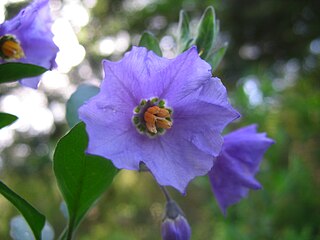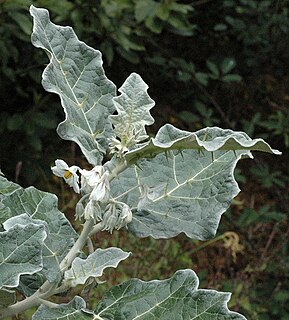
Solanum is a large and diverse genus of flowering plants, which include three food crops of high economic importance, the potato, the tomato and the eggplant. It also contains the nightshades and horse nettles, as well as numerous plants cultivated for their ornamental flowers and fruit.

Solanum dulcamara is a species of vine in the potato genus Solanum, family Solanaceae. Common names include bittersweet, bittersweet nightshade, bitter nightshade, blue bindweed, Amara Dulcis, climbing nightshade, fellenwort, felonwood, poisonberry, poisonflower, scarlet berry, snakeberry, trailing bittersweet, trailing nightshade, violet bloom, and woody nightshade.

Solanum mauritianum is a small tree or shrub native to South America, including Northern Argentina, Southern Brazil, Paraguay and Uruguay. It has become a widespread invasive weed in Azores Islands, Cook Islands, Fiji, Hawai‘i, New Caledonia, Norfolk Island, Solomon Islands, Tonga, Réunion Island, Mauritius, Madagascar, Australia, New Zealand, India, Sri Lanka and several southern African countries. Its common names include earleaf nightshade, woolly nightshade, flannel weed, bugweed, tobacco weed, tobacco bush, wild tobacco and kerosene plant.

Solanum americanum, commonly known as American black nightshade, small-flowered nightshade or glossy nightshade is a herbaceous flowering plant of wide though uncertain native range. The certain native range encompasses the tropics and subtropics of the Americas, Melanesia, New Guinea, and Australia.

Solanum nigrum, the European black nightshade or simply black nightshade or blackberry nightshade, is a species of flowering plant in the genus Solanum, native to Eurasia and introduced in the Americas, Australasia, and South Africa. Ripe berries and cooked leaves of edible strains are used as food in some locales, and plant parts are used as a traditional medicine. A tendency exists in literature to incorrectly refer to many of the other "black nightshade" species as "Solanum nigrum".

Solanum ptychanthum, the West Indian nightshade or eastern black nightshade, is an annual or occasionally perennial plant in the Solanaceae (Nightshade) family. It is typically 15–60 cm tall and many branched.

Solanum elaeagnifolium, the silverleaf nightshade or silver-leaved nightshade, is a common native plant to parts of the sw USA, and sometimes weed of western North America and also found in South America. Other common names include prairie berry, silverleaf nettle, white horsenettle or silver nightshade. In South Africa it is known as silver-leaf bitter-apple or satansbos. More ambiguous names include "bull-nettle", "horsenettle" and the Spanish "trompillo". The plant is also endemic to the Middle East.

Solanum xanti, known commonly as chaparral nightshade, purple nightshade, and San Diego nightshade, is a member of the genus Solanum. It is native to the Western United States in Arizona, California, Nevada, and Oregon, and to northwest Mexico in Baja California.
Pierreodendron kerstingii is a species of tree in the family Simaroubaceae. It is endemic to West Africa and found in Ivory Coast, Ghana, Togo, and Benin. It is sometimes considered synonym of Pierreodendron africanum, which would then be a widespread species distributed south to Angola and east to the Democratic Republic of the Congo.
Solanum chrysophyllum is a flowering plant species in the nightshade family (Solanaceae). It probably belongs to a group of species formerly in Solanum but nowadays placed in Lycianthes, though its exact identity and name remain undetermined.
"Solanum lanuginosum" is a flowering plant species in the nightshade family (Solanaceae). It probably belongs to those species formerly in Solanum but nowadays placed in Lycianthes, though its exact identity and name remain undetermined.
"Solanum loxense" is a flowering plant species in the nightshade family (Solanaceae). It probably belongs to those species formerly in Solanum but nowadays placed in Lycianthes, though its exact identity and name remain undetermined.

Xylopia africana is a species of plant in the Annonaceae family. It is found in west-central Africa. It is restricted to submontane and lower montane forests. It is threatened due to habitat loss by clearance of forest. It was first described as Melodorum africanum in 1862 by George Bentham.

Solanum marginatum is a species of plant in the family Solanaceae known by the common names purple African nightshade and white-margined nightshade. It is native to Ethiopia and Eritrea, and it is known on other continents as an introduced species and sometimes a weed. It is a hairy shrub growing up to two meters tall. The large, distinctive, gray-green leaves are wavy along the edges, woolly on the undersides, and measure up to 18 centimeters long. The veins are white and lined with large, widely spaced prickles. The inflorescence contains several white flowers, hanging or nodding bisexual flowers and erect staminate flowers with large yellow anthers. The fruit is a yellow berry up to 5 centimeters wide.

Solanum diphyllum, commonly known as the twoleaf nightshade, is a species of nightshade native to the Americas. It is cultivated as an ornamental plant for its clusters of dark green round fruits that turn a bright yellow when ripe.

Solanum tampicense, also known as wetland nightshade, aquatic soda apple, and scrambling nightshade, is a perennial in the Solanaceae or Nightshade Family. It can exist as a vine, tree, or shrub and is native to the West Indies and Central America. It is classified as a noxious weed by the United States Department of Agriculture and by several states and is known as an invasive species in the state of Florida.

Solanum sandwicense is a rare species of flowering plant in the nightshade family known by the common names Hawai'i horsenettle and popolo 'aiakeakua. It is endemic to Hawaii, where it occurs today on the islands of Kauai and Oahu. It is threatened by the destruction and degradation of its habitat. It is a federally listed endangered species of the United States.

Solanum villosum, the hairy nightshade, red nightshade or woolly nightshade, is a sprawling annual weed in Europe, western Asia, northern Africa, North America, and is also naturalized in Australia.

African nightshades are several species of plants in the section Solanum of the genus Solanum, that are commonly consumed as leafy vegetables and herbs. African nightshades are grown in both high and lowland areas in West and East Africa, particularly in Nigeria and Cameroon. There is a large variation in diversity of the African nightshades, which have many nutritional and medicinal benefits, even though the family of nightshade is commonly known as comprising dangerous weeds or poisonous plants. Species known as African nightshade include Solanum scabrum, Solanum villosum, Solanum nigrum, and Solanum americanum. Other common names for African nightshade are Black nightshade and Narrow-leaved nightshade. Local names of African nightshade include mnavu (Swahili), managu (Kisii), namasaka (Luhya), osuga (Luo), isoiyot (Kipsigis), kitulu (Kamba), ormomoi (Maa), ndunda (Taita), nsugga (Luganda), sochot (Keiyo), and esisogho (Lukhonzo).

The Solanaceae, or nightshades, are a family of flowering plants that ranges from annual and perennial herbs to vines, lianas, epiphytes, shrubs, and trees, and includes a number of agricultural crops, medicinal plants, spices, weeds, and ornamentals. Many members of the family contain potent alkaloids, and some are highly toxic, but many—including tomatoes, potatoes, eggplant, bell and chili peppers—are used as food. The family belongs to the order Solanales, in the asterid group and class Magnoliopsida (dicotyledons). The Solanaceae consists of about 98 genera and some 2,700 species, with a great diversity of habitats, morphology and ecology.
















